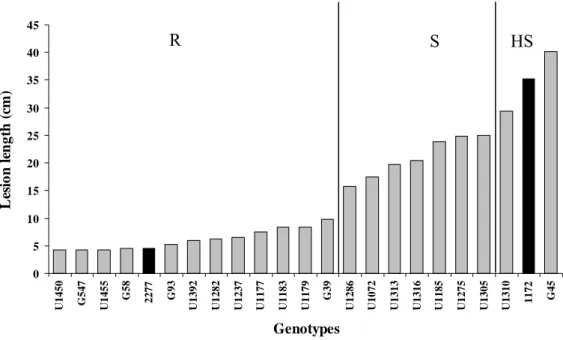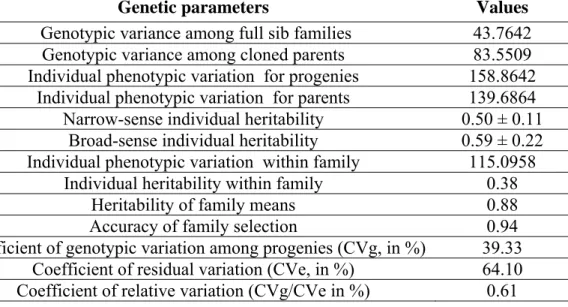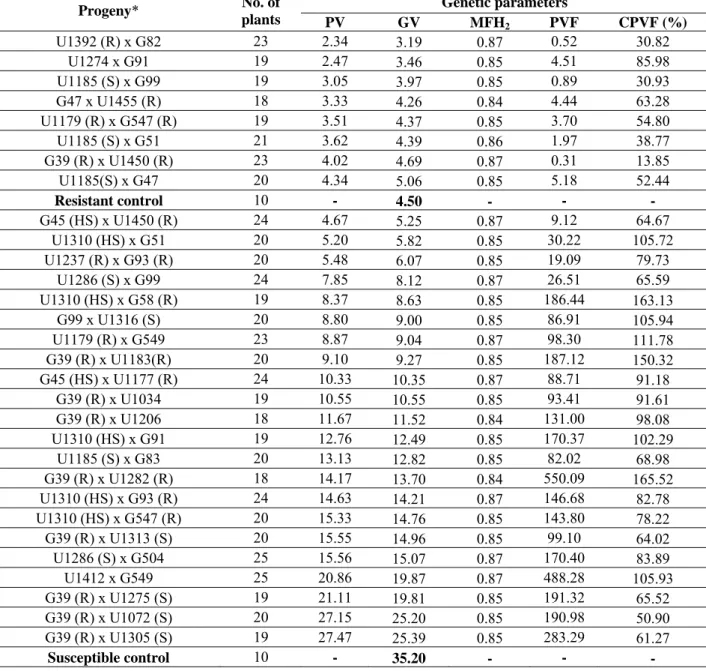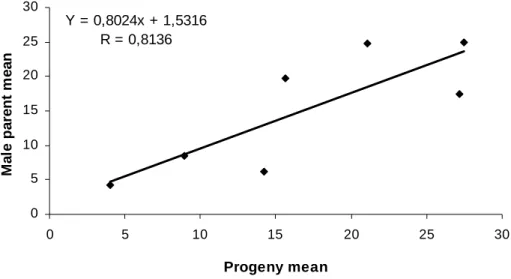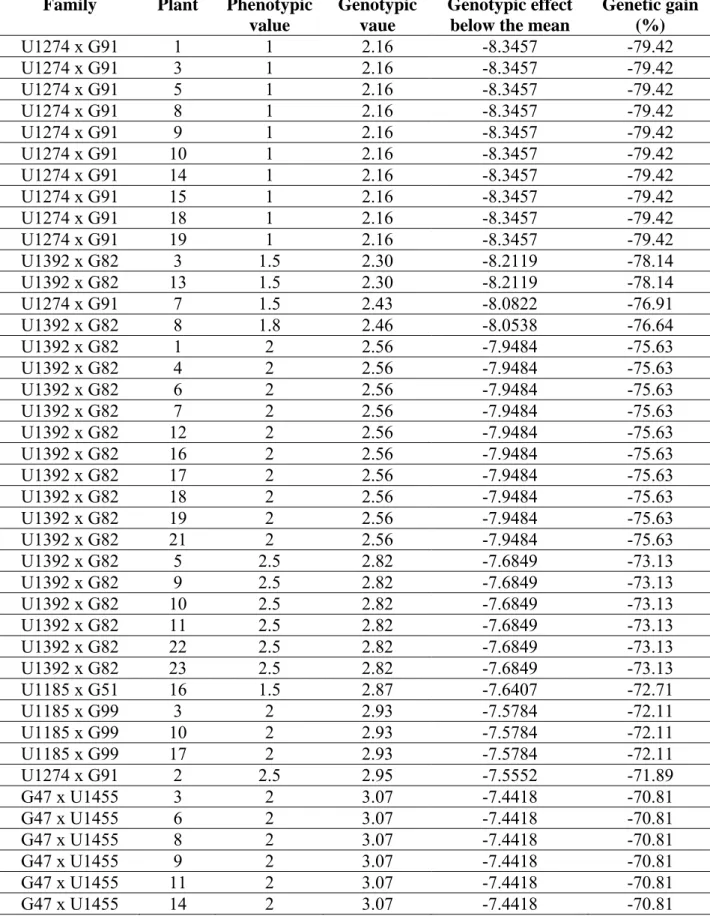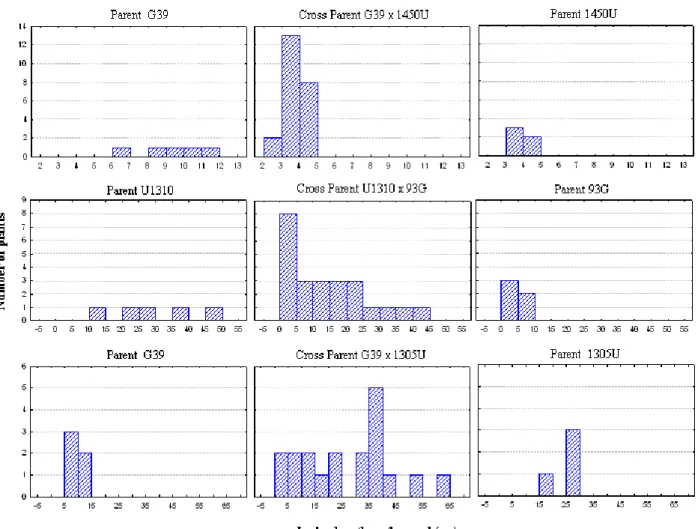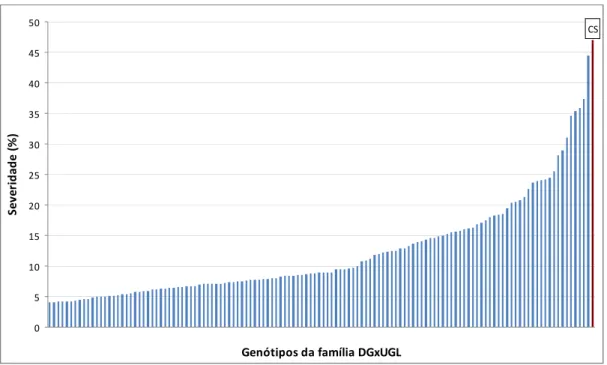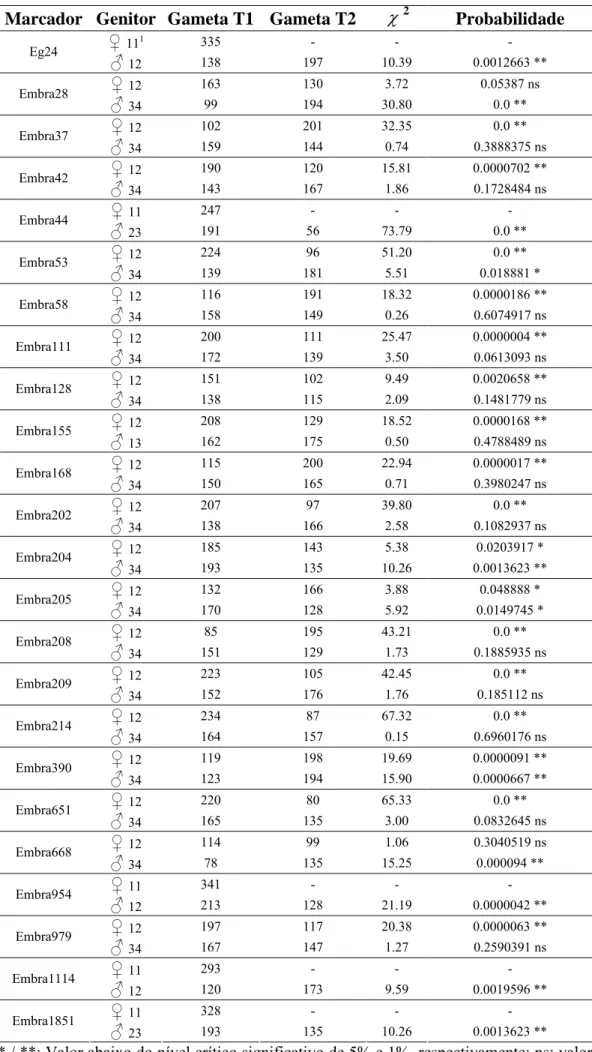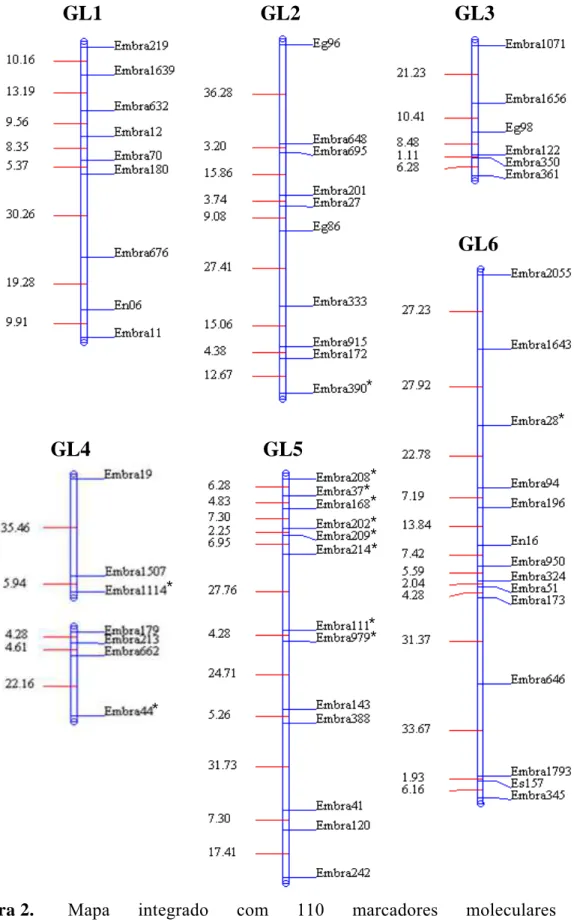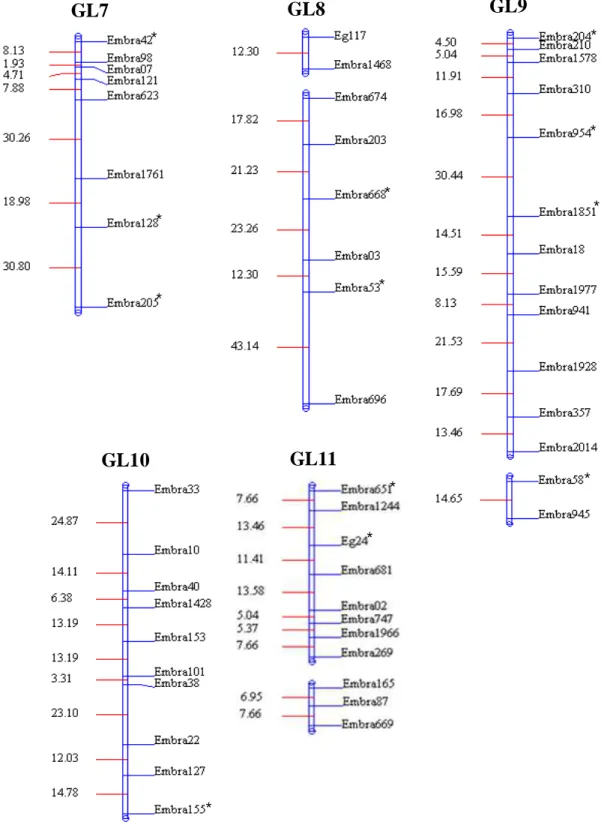CARLA CRISTINA GONÇALVES ROSADO
GENÉTICA DA RESISTÊNCIA À MURCHA-DE-CERATOCYSTIS (Ceratocystis fimbriata) EM Eucalyptus spp.
Dissertação apresentada à Universidade Federal de Viçosa, como parte das exigências do Programa de Pós-Graduação em Genética e Melhoramento, para obtenção do título de Magister Scientiae.
VIÇOSA
ii
iii Aos meus pais,
Paulo Afonso da Silva Rosado Maria Elizabete Gonçalves Rosado
Aos meus irmãos,
Carlos Antônio Gonçalves Rosado Paulo Henrique Gonçalves Rosado
Ao meu grande amor
Marcos Gomide de Andrade
iv
AGRADECIMENTOS
A Deus, pelo dom da vida.
À Universidade Federal de Viçosa, particularmente ao Programa de Pós Graduação em Genética e Melhoramento.
À Coordenação de Aperfeiçoamento de Pessoal de Nível Superior –
CAPES, pela concessão da bolsa de estudo durante o curso.
À Veracel S.A., pelo fornecimento dos genitores e progênies para a execução da primeira parte deste trabalho, em especial a David Evandro Fernandes e Sézar Augusto.
À Suzano Papel e Celulose, pelo fornecimento das mudas para a execução de parte deste trabalho, em nome dos engenheiros Edival Zauza e Leandro de Siqueira.
Ao Prof. Acelino Couto Alfenas pela amizade, pelos conselhos, ensinamentos, pela orientação, pelas críticas e sugestões, além do apoio durante a realização deste trabalho.
Ao Prof. Cosme Damião Cruz pelo exemplo como pessoa e profissional, pelo apoio incondicional no meu desenvolvimento acadêmico, pela co-orientação e pelas sugestões na construção dos mapas genéticos e detecção de QTLs.
v
Ao Dr. Marcos Deon Vilela Resende pela co-orientação, pelas críticas e sugestões a este trabalho.
Ao Dr. Lúcio Mauro Silva Guimarães pela amizade e pelas inúmeras revisões e críticas deste trabalho.
Ao Dr. Dario Grattapaglia e à Dra. Danielle de Assis de Faria da Embrapa/CENARGEN pelas análises moleculares e pela disposição em me ajudar sempre que foi necessário durante o período em que estive em Brasília.
À Dra. Tatiana Rosado, pela amizade, pelos conselhos, pelas críticas e sugestões na realização deste trabalho.
À Márcia Brandão pela amizade, pelo carinho e por ter sido sempre tão eficiente.
Aos meus amigos do Laboratório de Patologia Florestal e Genética da Interação Planta-Patógeno – BIOAGRO/UFV pela agradável convivência, em especial a Alexandre, Marisângela, Rodrigo, Talyta e Vanessa.
Aos colegas do Laboratório de Genética Vegetal, Embrapa/CENARGEN, por terem me apoiado e muito me ensinado durante o período em que estive em Brasília, em especial à Juliana Stival, Laís Pinheiro, Leonardo Correia e Marília Pappas.
Aos amigos do Programa de Pós-graduação em Genética e Melhoramento
da UFV.
Aos meus avós, tios, padrinhos e queridos primos, pelo carinho, orações e torcida.
Aos meus pais Paulo Afonso e Maria Elizabete e meus irmãos Carlos Antônio e Paulo Henrique, pela amizade, compreensão, estímulo e tantas outras coisas inumeráveis.
vi
Às minhas cunhadas, Cristiana Barbosa e Paloma Sayegh Arreguy Rosado, pela amizade.
Ao meu grande amor, Marcos Gomide de Andrade, por tudo que vivemos juntos, pela nossa cumplicidade, pelo amor incondicional e por sempre acreditar em mim.
vii BIOGRAFIA
Carla Cristina Gonçalves Rosado filha de Paulo Afonso da Silva Rosado e Maria Elizabete Gonçalves Rosado nasceu em Viçosa, Minas Gerais, em 05 de maio de 1984.
Iniciou o ensino fundamental em 1990 na Escola Estadual Effie Rolfs, onde concluiu o ensino fundamental no ano de 1998 e também o ensino médio em 2001.
Em maio de 2002, ingressou no curso de Engenharia Florestal, na Universidade Federal de Viçosa (UFV), no qual foi bolsista de iniciação científica, sob orientação do Professor Acelino Couto Alfenas. Graduou-se em 16 de março de 2007, obtendo o título de Engenheira Florestal.
Em seguida, iniciou o curso de Mestrado em Genética e Melhoramento na Universidade Federal de Viçosa, sob orientação do Professor Acelino Couto Alfenas.
viii SUMÁRIO
RESUMO...ix
ABSTRACT...xi
ARTIGO 1 - RESISTANCE TO CERATOCYSTIS WILT (CERATOCYSTIS FIMBRIATA) IN PARENTS AND PROGENIES OF EUCALYPTUS GRANDIS X E. UROPHYLLA...12
ABSTRACT ...12
INTRODUCTION...13
MATERIALANDMETHODS...14
Plant Material...14
Inoculation...14
Data evaluation and analysis ...15
RESULTS...19
DISCUSSION ...20
ACKNOWLEDGEMENTS ...22
REFERENCES...22
ARTIGO 2 - MAPEAMENTO GENÉTICO DE QTLS PARA RESISTÊNCIA À MURCHA-DE-CERATOCYSTIS (CERATOCYSTIS FIMBRIATA) EM CRUZAMENTOS INTERESPECIFÍCOS DE EUCALYPTUS SPP....32
RESUMO...32
INTRODUÇÃO...33
MATERIALEMÉTODOS...34
Material vegetal...34
Inoculação e avaliação...35
Amplificação dos locos microssatélites ...35
Geração dos dados genotípicos...36
Mapeamento Genético ...36
Detecção de QTLs ...37
RESULTADOSEDISCUSSÃO...40
REFERÊNCIASBIBLIOGRÁFICAS...46
CONCLUSÕES GERAIS ...56
ARTIGO 1:...56
ix
RESUMO
ROSADO, Carla Cristina Gonçalves. M.Sc., Universidade Federal de Viçosa, fevereiro de 2009. Genética da resistência à murcha-de-ceratocystis (Ceratocystis fimbriata) em Eucalyptus spp. Orientador: Acelino Couto Alfenas. Coorientadores: Cosme Damião Cruz, Douglas Lau e Marcos Deon Vilela Resende.
A murcha-de-ceratocystis (Ceratocystis fimbriata) é atualmente uma das principais enfermidades em plantios comerciais de eucalipto no Brasil. Os principais sintomas causados pela doença são murcha, cancro, escurecimento radial do lenho e morte da planta. O uso de genótipos de eucalipto resistentes é a melhor alternativa de controle. Embora existam genótipos resistentes, a base genética da resistência não é conhecida. Sendo assim, no presente trabalho objetivou-se: 1) determinar o nível de resistência de genótipos de Eucalyptus grandis e E. urophylla e estimar a possibilidade de transferência da resistência por meio de cruzamentos interespecíficos controlados entre essas duas espécies; 2) construir um mapa genético, detectar e quantificar os efeitos de QTLs para resistência à murcha-de-ceratocystis utilizando marcadores microssatélites em uma família de irmãos completos proveniente de um cruzamento interespecífico. Na primeira parte do trabalho, avaliaram-se cinco genitores de E. grandis e 16 de
E. urophylla, além de 30 progênies E. grandis x E. urophylla (18 a 25 plantas por progênie). Para a avaliação da resistência foram inoculadas, em condições controladas, cinco réplicas de cada genitor e de cada um dos indivíduos da progênie, com o isolodado SBS-1 de C. fimbriata. Dos 21 genitores avaliados, 12 foram resistentes e nove suscetíveis, independentemente da espécie. As estimativas das herdabilidades individuais no sentido amplo e restrito equivaleram a 59% e 50%, respectivamente, sugerindo que a resistência genética à murcha-de-ceratocystis apresenta alto grau de controle genético e baixa dominância alélica.
x
xi
ABSTRACT
ROSADO, Carla Cristina Gonçalves. M.Sc., Universidade Federal de Viçosa, February 2009. Genetics of ceratocystis wilt (Ceratocystis fimbriata) resistance in Eucalyptus spp. Advisor: Acelino Couto Alfenas. Co-advisors: Cosme Damião Cruz, Douglas Lau and Marcos Deon Vilela Resende.
The ceratocystis wilt (Ceratocystis fimbriata) is currently, one of the most important diseases in commercial eucalypt plantations in Brazil. The main symptoms are wilting, canker and wood darkening. The use of resistant
Eucalyptus genotypes is the best control method. Despite the existence of resistant genotypes, the genetic basis of resistance is unknown. Therefore, the present study aimed to: 1) determine the resistance level of Eucalyptus grandis and E. urophylla
genotypes and estimate the possibility to transfer the resistance between these two species through controlled interspecific crosses, 2) build a genetic map, detect and quantify the effects of QTL on ceratocystis wilt resistance using microsatellite markers in an interspecific full sibling family. On the first part of this work five parents of E. grandis and 16 E. urophylla, and 30 progenies E. grandis x E. urophylla (18 to 25 plants per progeny) were evaluated. For resistance screening, five replicates of each parent and each individual progeny, were inoculated under controlled conditions with the SBS-1 C. fimbriata isolate. From 21 parents assessed, twelve were resistant and nine susceptible, independently on the species. Estimates of individual narrow (50%) and broad (59%) sense heritability suggested a high degree of genetic control and low allelic dominance of the trait. Wide genetic variation among and within families was detected, a fact that contributes to high heritability and genetic gain. A selection of the 50 clones most
xii
of 127 individuals of progeny DGxUGL [(E. grandis x E. dunnii) x (E. urophylla
1
INTRODUÇÃO GERAL
Atualmente as espécies do gênero Eucalyptus são as essências florestais mais plantadas no mundo, com aproximadamente 18 milhões de hectares (FAO, 2007). O Brasil ocupa lugar de destaque como um dos países de maior área plantada com eucalipto, com aproximadamente 3,75 milhões de hectares. Estima-se que 85% dessa área estejam distribuídos nas regiões Sul e Sudeste, para a produção de madeira para celulose e papel (ABRAF, 2008).
Com a ampliação das áreas plantadas, especialmente em regiões quentes e úmidas, tem sido crescente o surgimento de novas enfermidades que afetam a cultura e causam perdas significativas na produção (ALFENAS et al., 2004). Dentre essas, a murcha-de-ceratocystis, causada pelo fungo Ceratocystis fimbriata
Ellis & Halsted, é uma das mais importantes devido à sua natureza letal, ampla distribuição geográfica, variada gama de hospedeiros e variabilidade genética na população do patógeno (ALFENAS & GUIMARÃES, 2007). Ceratocystis fimbriata já foi detectado em 31 espécies de 14 diferentes famílias, entre elas espécies arbóreas, como plátano (Platanus spp.), mangueira (Mangifera indica
L.), gmelina (Gmelina arborea Roxb.), cacaueiro (Theobroma cacao L.), cafeeiro (Coffea arabica L.), seringueira (Hevea brasiliensis (Willd. Ex Adr. Juss.) Müll. Arg.), espatódea (Spathodea sp.), fícus (Ficus carica L.), acácia (Acacia spp.) e
eucalipto (Eucalyptus spp.) (BAKER et al., 2003). A existência de variabilidade inter e intra-específica para a resistência a essa doença (ZAUZA et al., 2004; ALFENAS et al., 2004) torna a seleção de genótipos resistentes a melhor estratégia de controle. Atualmente, a incorporação de ferramentas e abordagens genômicas nos programas de melhoramento florestal poderá abrir novas perspectivas para a compreensão das relações patógeno-hospedeiro (GRATTAPAGLIA, 2007).
2
medula para o exterior do lenho, ou da periferia do lenho para a medula (FERREIRA et al., 2006b). O patógeno penetra na planta por ferimentos nos troncos e pelo contato das raízes, atingindo o coleto e tronco via parênquima medular, de onde, em diversas alturas, surgem estrias escuras, que progridem, via parênquima radial, matando uma porção de câmbio vascular, do floema e da feloderme, resultando numa lesão longitudinal externamente no tronco, contínua ou descontínua, levando à murcha e ao secamento da planta (FERREIRA et al.,
2006b).
O controle genético e os mecanismos de resistência do eucalipto à murcha-de-ceratocystis não são conhecidos, sendo esses principalmente estudados em espécies de Platanus. A identificação dos genes ou locos que controlam a resistência à murcha-de-ceratocystis são fundamentais para embasar o controle da doença por meio do plantio de genótipos resistentes. Em plátano (Platanus sp.) quando se obtêm híbridos entre indivíduos suscetíveis e resistentes é possível encontrar indivíduos altamente resistentes ao cancro provocado por C. platani. (VIGOUROUX & OLIVIER, 2004). Genótipos resistentes a C.platani acumulam maior concentração de fitoalexinas que os genótipos suscetíveis (EL MODAFAR et al., 1995). Uma glicoproteína isolada do fungo elicita a produção de tais compostos (ALAMI et al., 1998). Em genótipos suscetíveis, a aplicação de ácido
jasmônico induziu o acúmulo de fitoalexinas após a inoculação do patógeno ou da molécula elicitora (CLERIVET & ALAMI, 1999). Ceratocystis platani produz toxinas que induzem necrose da célula vegetal (PAZZAGLI et al., 1999), essenciais à patogênese. A capacidade da planta em neutralizar tais toxinas pode constituir um importante mecanismo de resistência.
3
bioinformática e genética estatística para integrar e disponibilizar toda a informação visando à seleção de árvores superiores (GRATTAPAGLIA, 2004; POKE et al., 2005).
Marcadores microssatélites são, atualmente, os mais indicados para a construção de mapas genéticos de alta resolução e cobertura em espécies florestais. Os microssatélites caracterizam-se pela natureza multialélica, herança co-dominante, abundância e transferibilidade entre espécies geneticamente relacionadas. A conservação de locos microssatélites entre as espécies do gênero
Eucalyptus torna possível a geração de mapas “consenso”, permitindo a comparação e integração de informação de mapeamento genético de marcadores, genes e QTLs entre experimentos independentes (GRATTAPAGLIA & KIRST, 2008).
O mapeamento genético em plantas é, geralmente, realizado por meio da análise de meioses geradas a partir de cruzamentos entre linhagens puras. Espécies florestais, em sua grande maioria plantas alógamas, possuem longo ciclo de vida e sofrem alta depressão endogâmica, o que dificulta, ou até impossibilita, a obtenção de linhagens homozigóticas. Portanto, o emprego de delineamentos clássicos de mapeamento não é recomendado, como populações F2, retrocruzamentos (RC) e linhagens recombinantes endogâmicas (RILs). Uma
alternativa para estudos de mapeamento genético é o uso de famílias exogâmicas, seja de meios-irmãos e irmãos completos.
4
loco A com alelos i, j, k e l, ter-se-ão os seguintes tipos de cruzamentos: cruzamento entre genitores homozigotos (I- AiAi-AiAi, II- AiAi-AjAj), cruzamento entre genitores homozigotos e heterozigotos (III- AiAi-AiAj , IV- AiAi-AjAk) e cruzamento entre genitores heterozigotos (V- AiAj, VI- AiAj-AiAk; VII- AiAj-AkAl). O tipo I envolve apenas um alelo, os tipos II, III e V dois alelos, os tipos IV e VI três alelos, e o tipo VII quatro alelos. Na análise de segregação, deve-se considerar que somente acasalamentos que envolvam pelo menos um dos genitores heterozigotos sejam informativos para fins de mapeamento. Dessa forma, apenas cruzamentos dos tipos III, IV, V, VI e VII são informativos.
Além da heterozigosidade observada entre genitores de um cruzamento exogâmico, deve ser verificada, adicionalmente, a existência de indivíduos informativos na progênie. Segundo Da & Lewin (1995), um marcador é considerado informativo quando a origem dos alelos dos indivíduos em uma progênie pode ser inequivocadamente determinada. Baseando-se nesse pressuposto, Lynch & Walsh (1998) propuseram de forma resumida três níveis de informatividade para cruzamentos exogâmicos, de acordo com os genitores envolvidos no cruzamento: Cruzamentos completamente informativos (AiAj x AkAl); em que a segregação esperada é de 1:1:1:1; cruzamento com um loco
informativo (AiAj x AkAk), a segregação esperada é 1:1 e cruzamentos parcialmente informativos (AiAj x AiAj), no qual a segregação esperada é de 1:2:1.
Os primeiros mapas genéticos gerados utilizaram um tipo de delineamento de irmãos completos, denominado de pseudo-cruzamento por envolver marcadores dominantes e a segregação ser analisada separadamente para cada genitor (GRATTAPAGLIA & SEDEROFF, 1994). Essa metodologia foi utilizada em diversos outros mapeamentos envolvendo não só Eucalyptus, mas também
5
dois mapas para os genitores e a dificuldade de integração dos mesmos em razão de não se ter marcadores comuns (âncoras) aos dois mapas gerados. Atualmente é possível obter mapa único em análise de pseudo-cruzamento teste, por meio da inclusão de marcadores com segregação 3:1, em alguns programas capazes de realizar os cálculos de freqüência de recombinação levando em consideração a informação simultânea das meioses dos dois parentais heterozigóticos para produzir um mapa integrado (STAM, 1993; BUTCHER et al., 2002; CRUZ, 2009). No entanto, somente Byrne et al. (1995), Thamarus et al. (2002), Novaes (2006) e Bhering (2008) construíram mapas integrados para ambos os parentais. No trabalho de Bhering (2008), utilizando o procedimento de simulação de dados, o autor concluiu que para locos completamente informativos, é possível calcular a freqüência de recombinação entre pares de locos, a partir da freqüência gamética de cada genitor, assim como a partir da freqüência genotípica da progênie, que é nos cruzamentos tipo VII, a média aritmética da freqüência de recombinação obtida com base na freqüência gamética ou individual.
É importante ressaltar que, em trabalhos de mapeamento genético envolvendo diferentes espécies de Eucalyptus, tem sido observados marcadores com distorção da razão de segregação esperada (DS) em diferentes níveis, geralmente maior para cruzamentos interespecíficos entre indivíduos de espécies
6
Os mapas genéticos, baseados em marcadores moleculares, tem se revelado como recurso analítico de valor inestimável. Por meio deles, torna-se possível identificar regiões genômicas que contenham genes ou seqüências regulatórias envolvidos no controle genético de características quantitativas (QTL) de importância econômica ou adaptativa.
O primeiro trabalho envolvendo mapeamento de QTL em eucalipto foi realizado por Grattapaglia et al. (1994), onde foram detectados QTLs para resposta à micropropagação, capacidade de enraizamento e brotação. Atualmente, existem poucos estudos descritos na literatura que visam mapeamento de QTL relacionados à resistência a doenças em espécies florestais. A maioria destes estudos geralmente restringe-se à ferrugem do eucalipto (Puccinia psidii), e, mais recentemente, para a mancha foliar e desfolha de Teratosphaeria spp. (=
Mycosphaerella), não sendo relatado, até o momento, estudos que visam à detecção e ao mapeamento de QTL que conferem resistência à murcha-de-ceratocystis. Com relação à ferrugem, destacam-se os trabalhos de Junghans et al. (2003), Rosado (2007) e Alves (2008). Junghans et al. (2003) mapearam, por meio de marcadores RAPD, o loco Ppr1 (Puccinia psidii resistance gene 1) responsável por conferir resistência à ferrugem em uma progênie de E. grandis. Rosado (2007), por meio de marcadores microssatélites, detectou um QTL
7
dados de infecção natural, onde pode haver plantas escapes e a infecção por mais de uma espécies de Teratosphaeria.
Assim, frente à importância recentemente atribuída à murcha-de-ceratocystis nos programas de melhoramento do eucalipto, há a necessidade de mapeamento de QTLs que controlam a resistência a essa doença, por meio de marcadores microssatélites para que a prática de Seleção Assistida por Marcadores (SAM) possa ser efetivamente implementada, e também a identificação da função de genes, possibilitando assim entender o controle genético dos caracteres sob estudo, no sentido de potencializar o uso da manipulação genética no melhoramento da espécie.
Sendo assim, no presente trabalho objetivou-se: 1) determinar o nível de resistência de genótipos de E. grandis e E. urophylla e estimar a possibilidade de transferência da resistência por meio de cruzamentos interespecíficos controlados entre essas duas espécies; 2) construir um mapa genético, utilizando marcadores microssatélites, para uma família derivada de um cruzamento entre quatro espécies, sendo um genitor híbrido de E. dunnii x E. grandis e outro de E.
urophylla x E. globulus, 3) detectar, mapear e quantificar o efeito e a importância de QTLs para resistência à murcha-de-ceratocystis, utilizando marcadores microssatélites em uma família interespecífica de irmãos completos de Eucalyptus
spp.
Esta dissertação encontra-se dividida em dois artigos:
• Artigo 1: Resistance to ceratocystis wilt (Ceratocystis fimbriata) in parents
and progenies of Eucalyptus grandis x E. urophylla
• Artigo 2: Mapeamento genético de QTLs para resistência à murcha-de-ceratocystis (Ceratocystis fimbriata) em cruzamentos interespecíficos de
8
REFERÊNCIAS BIBLIOGRÁFICAS
ABRAF. Anuário estatístico da ABRAF: ano base 2007 /ABRAF. Brasília: ABRAF, 2008. 90p.
ALAMI, I., MARI, S. & CLERIVET, A. A glycoprotein from Ceratocystis fimbriata f.sp. platani triggers phytoalexin synthesis in Platanus x Acerifolia cell suspension cultures. Phytochemistry 48:771-776. 1998.
ALFENAS, A.C., ZAUZA, E.A.V., MAFIA, R.G. & ASSIS, T.F. Clonagem e doenças do eucalipto. Ed. Viçosa MG. UFV. 2004.
ALFENAS, A. C. & GUIMARÃES, L. M. S. Resistência Genética em Patossistemas Florestais. Fitopatologia Brasileira 32 (Supl.): 89-91. 2007. (Resumo)
ALVES A.A. Herança e mapeamento genético da resistência à ferrugem (Puccinia psidii) em cruzamentos interespecíficos de Eucalyptus. Dissertação Mestrado. Viçosa MG. Universidade Federal de Viçosa. 2008.
BAKER, C.J., HARRINGTON, T.C., KRAUSS, U. & ALFENAS, A.C. Genetic variability and host specialization in the Latin American Clade of Ceratocystis fimbriata. Phytopathology 93:1274-1284. 2003.
BHERING L.L. Mapeamento genético em famílias simuladas de irmãos completos. Tese Doutorado. Viçosa MG. Universidade Federal de Viçosa. 2008. BUTCHER, P.A., WILLIAMS, E.R., WHITAKER, D., LING, S., SPEED, T.P. & MORAN, G.F. Improving linkage analysis in outcrossed forest trees - an example from Acacia mangium. Theoretical and Applied Genetics 104:1185-1191. 2002.
BYRNE, M., MURRELL, J.C., ALLEN, B. & MORAN, G.F. An integrated linkage genetic linkage map for Eucalyptus using RFLP, RAPD and isozyme markers. Theoretical and Applied Genetics 91:869-875. 1995.
CARLSON, J.E., TULSIERAM, L.K., GLAUBITZ, J.C., LUK, V.W.K., KAUFFELDT, C. & RUTLEDGE, R. Segregation of random amplified DNA markers in F1 progeny of conifers. Theoretical and Applied Genetics 83:194-200. 1991.
CERVERA, M.T., STORME, V., IVENS, B., GUSMÃO, J., LIU, B.H.,
9
CLERIVET, A. & ALAMI, I. Effects of jasmonic acid and of an elicitor from
Ceratocystis fimbriata f.sp. platani on the accumulation of phytoalexins in leaves of susceptible and resistant plane trees. Plant Science 148:105-110. 1999.
CRUZ, C.D., GOD, P.I.V.G. & BHERING, L.L. Mapeamento de QTLs em populações exogâmicas. In: Borém, A. (Ed.) Marcadores moleculares. 2ª ed. Viçosa MG. Editora UFV. 2009. pp. 443-481.
Cruz, C.D. GQMOL: Programa para análise de genética quantitativa molecular. Versão 2007.2.1. Desenvolvido pelo setor de Genética da Universidade Federal de Viçosa. Disponível em: www.ufv.br/dbg/gqmol/gqmol.htm
DA, Y. & LEWIN, H. A. Linkage information content and efficiency of full-sib and half-sib desings for gene mapping. Theoretical and Applied Genetics 90:699-706. 1995.
EL MODAFAR, C., CLERIVET, A., VIGOUROUX, A. & MACHEIX, J.J. Accumulation of phytoalexins in leaves of plane tree (Platanus spp.) expressing susceptibility or resistance to Ceratocystis fimbriata f. sp. platani. European Journal of Plant Pathology 101:503-509. 1995.
FAO. Global forest resources assessment 2007 - Main report. FAO Forestry paper. ISSN 0258-6150, 2007. 479 p. Disponível em: www.fao.org/forestry/fo/fra/main/index.jsp.
FERREIRA A. Mapeamento genético utilizando marcadores moleculares com distorção de segregação gamética e genotípica. Tese Doutorado. Viçosa MG. Universidade Federal de Viçosa. 2006a.
FERREIRA, F.A., MAFFIA, L.A., BARRETO, R.W., DEMUNER, N.L. & PIGATTO, S. Sintomatologia de murcha de Ceratocystis fimbriata em Eucalipto. Revista Árvore 30:155-162. 2006b.
FERREIRA, F.A., DEMUNER, A.M. & PIGATTO, S. Murcha-de-ceratocystis em eucalipto no Brasil. Fitopatologia Brasileira 32 (Supl.):284. 1999. (Resumo)
FREEMAN, J.S., POTTS, B.M. & VAILLANCOURT, R.E. Few Mendelian genes underlie response of a forest tree, Eucalyptus globules, to a natural fungal epidemic. Genetics 178:563-571. 2008.
GRATTAPAGLIA, D. Mapas Genéticos e Seleção Assistida por Marcadores Moleculares. In: Borém, A. (Ed.) Biotecnologia Florestal. Viçosa MG. Editora UFV. 2007. pp. 201-230.
GRATTAPAGLIA, D. Integrating Genomics into Eucalyptus breeding. Genetics and Molecular Research 3:369-379. 2004.
10
GRATTAPAGLIA, D. & KIRST, M. Eucalyptus applied genomics: from gene sequences to breeding tools. New Phytologist 179:911-929. 2008.
GRATTAPAGLIA, D. & SEDEROFF, R. Genetic linkage maps of Eucalyptus grandis and E. urophylla using a pseudo-testcross mapping strategy and RAPD markers. Genetics 137:1121-1137. 1994.
HASEMAN, J.K. & ELSTON, R.C. The investigation of linkage between a quantitative trait and a marker locus. Behav. Genetics 2:3-19. 1972.
JUNGHANS, D.T., ALFENAS, A.C., BROMMONSHENCKEL, S.H., ODA, S., MELLO, E.J. & GRATTAPAGLIA, D. Resistance to rust (Puccinia psidii
Winter) in Eucalyptus: mode of inheritance and mapping of a major gene with RAPD markers. Theoretical and Applied Genetics 108: 175-180. 2003.
LIANG, X.S., ZHEN, X.S. & ZHEN, Z.T. Segregation distortion and its effect on genetic mapping in plants. Chinese Journal of Agricultural Biotechnology 3:163-169. 2006.
LYNCH, M. & WALSH, B. Genetics and analysis of quantitative traits. Inc. Ed. Sunderland MA. Sinauer Associates. 1998.
MARQUES, C.M., ARAUJO, J.A., FERREIRA, J.G., WHETTEN, R., O'MALLEY, D.M., LIU, B.H. & SEDEROFF, R. AFLP genetic maps of
Eucalyptus globulus and E. tereticornis. Theoretical and Applied Genetics
96:727-737. 1998.
MISSIAGGIA A.A. Mapeamento Genético de QTL para qualidade da madeira e florescimento precoce e, estudos de expressão gênica alelo específica em Eucalyptus spp. Tese Doutorado. Piracicaba SP. Escola Superior de Agricultura "Luiz de Queiroz". 2005.
MYBURG, A.A., GRIFFIN, A. R., SEDEROFF, R. R. & WHETTEN, R. W. Comparative genetic linkage maps of Eucalyptus grandis, Eucalyptus globulus and their F1 hybrid based on a double pseudo-backcross mapping approach. Theoretical and Applied Genetics 107:1028-1042. 2003.
NOVAES E. Mapeamento de QTLS para qualidade da madeira em Eucalyptus grandis x E. urophylla e ancoragem de clones BAC no mapa genético. Dissertação Mestrado. Viçosa MG. Universidade Federal de Viçosa. 2006.
PAZZAGLI, L., CAPPUGI, G., MANAO, G., CAMICI, G., SANTINI, A., SCALA, A. Purification, characterization, and amino acid sequence of cerato-platanin, a new phytotoxic protein from Ceratocystis fimbriata f. sp. platani. The Journal of Biological Chemistry 274:24959-24964. 1999.
11
ROSADO T.B. Mapeamento de gene letal, responsável pela distorção da segregação e detecção de QTL para a resistência à ferrugem (Puccinia psidii) em Eucalyptus spp. Tese Doutorado. Viçosa MG. Universidade Federal de Viçosa. 2007.
STAM, P. Construction of integrated genetic linkage maps by means of a new computer package: JoinMap. The Plant Journal 3:739-744. 1993.
THAMARUS, K. A.,GROOM, K., MURRELL, J., BYRNE, M. & MORAN, G. F. A genetic linkage map for Eucalyptus globulus with candidate loci for wood, fibre, and floral traits. Theoretical and Applied Genetics 104:379-387. 2002.
VIGOUROUX, A. & OLIVIERE, R. First hybrid plane trees to show resistance against canker stain (Ceratocystis fimbriata f. sp. platani). Forest Pathology 34:307–319. 2004.
12
Artigo 1 - Resistência à murcha-de-ceratocystis (Ceratocystis fimbriata) em
genitores e progênies de Eucalyptus grandis x E. urophylla
RESISTANCE TO CERATOCYSTIS WILT (CERATOCYSTIS FIMBRIATA) IN PARENTS AND PROGENIES OF EUCALYPTUS
GRANDIS X E. UROPHYLLA
Carla Cristina Gonçalves Rosado1, Lúcio Mauro da Silva Guimarães1, Miranda Titon1,
Douglas Lau2, Leonardo Rosse3, Marcos Deon Vilela de Resende4 and Acelino Couto
Alfenas1* 1)
Departamento de Fitopatologia/BIOAGRO, Universidade Federal de Viçosa (UFV), 36570-000,
Viçosa, MG, Brazil. *Corresponding author: Acelino Couto Alfenas,E-mail: aalfenas@ufv.br, Telephone: +55 (31) 3899-2939.
2)
EMBRAPA Trigo, Rodovia BR 285, Km 294, 99001-970, Passo Fundo, RS, Brazil.
3)
VERACEL S.A. Rodovia BA-275, Km 24, 45820-970, Eunápolis, BA, Brazil.
4)
EMBRAPA Florestas, Estrada da Ribeira, Km 111, 83411-000, Colombo, PR, Brazil.
Para submissão na revista Silvae Genetica
ABSTRACT - Ceratocystis wilt, caused by Ceratocystis fimbriata, is one of the most damaging diseases in eucalyptus plantations worldwide. Although there are resistant
genotypes, the genetic basis of resistance is still poorly understood. In this paper we
studied the resistance level by a stem inoculation experiment of genotypes of Eucalyptus
grandis and E. urophylla and estimated the heritability and gains of selection in families
derived from controlled interspecific crosses. In both species, highly resistant as well as
highly susceptible genotypes to Ceratocystis wilt were found. Out of 21 parents assessed,
twelve were resistant and nine susceptible. Estimates of individual narrow (50%) and
broad (59%) sense heritability suggested a high degree of genetic control and low allelic
dominance of the trait. There was great genetic variation among and within families, a
fact that contributes to high heritability and genetic gain. A genetic gain in lesion size of
up to -74.4% was obtained from selection of the 50 best clones in the evaluated families,
i.e., the mean lesion length in the progeny population can be reduced by 74,4%.
13 INTRODUCTION
Due to its lethal nature, broad range of hosts and wide geographical distribution, the Ceratocystis wilt caused by Ceratocystis fimbriata Ellis & Halsted is currently one of the most damaging diseases of eucalyptus plantations in Brazil (ALFENAS et al., 2004). Besides eucalyptus, C. fimbriata also infects other crops of economic importance, such as mango (Mangifera indica L.) (VIEGAS, 1960), coffee (Coffea arabica L.) (MARIN, 2003), black-wattle (Acacia mearnsii of Wild.) (RIBEIRO and ITO, 1988; SANTOS and FERREIRA, 2003), taro (Colocasia esculenta) (HARRINGTON et al., 2005) and crotalaria (Crotalaria juncea L.) (RIBEIRO et al., 1977). The main symptoms caused by C. fimbriata in eucalyptus are wilting, canker and wood darkening. The pathogen penetrates the plant through fresh wounds on the stem and root contact and attains the stem and trunk via medullar parenchyma. Dark stripes originates from the medulla spread through the radial parenchyma up to different heights and may reach in the stem. The fungus also kills partially of the vascular cambium, the phloem and pheloderm, resulting in longitudinal, continuous or interrupted lesions on the outer part of the trunk, which cause tree wilting and death (FERREIRA et al., 2006).
Besides C. fimbriata, other species such as C. eucalypti, C. moniliformis,
C. moniliformopsis and C. pirilliformis have been reported in eucalyptus (BARNES
and ROUX, 2003). Of these, only C. fimbriata is known to be pathogenic and was reported for the first time causing wilting and plant death of Eucalyptus spp. in the Southeast of the State of Bahia in 1997 (FERREIRA et al., 1999). Ceratocystis fimbriata has also been reported in eucalyptus in Uruguay (BARNES et al., 2003), in the Republic of Congo (ROUX et al., 2000), in Uganda (ROUX et al., 2001) and in the South Africa (ROUX et al., 2004).
14
genotypes and to estimate the possibility of resistance transferring through controlled interspecific crosses between these two species.
MATERIAL AND METHODS
Plant Material
The resistance to ceratocystis wilt of five elite genotypes of E. grandis
(G39, G45, G58, G93 and G547) and 16 of E. urophylla (U1072, U1177, U1179,
U1183, U1185, U1237, U1275, U1282, U1286, U1305, U1310, U1313, U1316, U1392, U1450, and U1455) was assessed. Segregation in 30 hybrid progenies derived from controlled E. grandis x E. urophylla crosses was also evaluated. Five replicates of each parent and 18 to 25 plants per progeny were inoculated, depending on the cross (Table 2). Not all parents of the evaluated progenies were inoculated, since they would not be propagated by rooted cuttings. However these progenies were used to estimate the genetic gains. The rooted cuttings and seedlings (90 days old) were transplanted to 2L pots, containing a mixture of soil:sand:manure (3:1:1). Ouro Verde® fertilizer (15-15-20 NPK and low quantities of Ca, S, Mg, Zn, B, Fe, and Mn) was applied twice a week (100mL/plant at 7,5g/L) until the plants reached an adequate development stage for inoculation, 60 days after transplanting (plants of 1.5 to 2.0 cm diameter and 60 cm hight). Daily mean temperature in the period was of 25 ± 3°C. Irrigation was conducted 2-3 times a day according to the plant needs.
Inoculation
In the experiment, it was used a culture medium (SBS-1) of C. fimbriata,
15
A cut lengthwise approximately 2 cm length was made on the stem (about 3 cm above soil surface) and 0.5 mL of the spore suspension was deposited and the inoculation area was covered with plastic film. Ten replicates of each of the clones HRC2277 (natural hybrid of E. grandis x E. urophylla) and HGU1172 (hybrid E. grandis x E. urophylla) were used as resistant and susceptible controls, respectively.
Data evaluation and analysis
The lesion lenght on the xylem was determined 60 days after inoculation and the data were analyzed using the programs Statistica ® version 5.0 (StatSoft), Genes ® version 2007.0.0 (CRUZ, 1997) and Selegen-Reml/Blup ® (RESENDE,
2002; DUNLOP et al., 2005). The Scott & Knott grouping test (p ≤ 0.01) was used to classify the parents as resistant or susceptible.
The phenotypic, genetic and environmental variances were estimated for each family, based on the procedure for families with intercalated controls (CRUZ, 1997), the adjusted analysis model and parameters estimated by the methodology of mixed linear models (REML - residual maximum likelihood and BLUP - best linear unbiased prediction). Five replications of each resistant and susceptible clone were employed as intercalated control. The REML/BLUP method was fitted based on the following mixed model: y = Xf + Zg + e, where: y, f, g and e are vectors of data, of fixed effects (means of controls and the progeny population), genotypic effects of families and parents (random) and random errors, respectively, and X and Z: incidence matrices for f and g, respectively.
From the fitting of the model for the experiment with families and also for the experiment with parents, estimates of variance components (via REML) and the heritability in the narrow and broad sense were obtained. Genotypic values for each individual of the hybrid families were also predicted and gains with genetic
selection estimated within families and also in the hybrid population as a whole. The prediction of gains with selection (GS) was based on the selection of the 50 best plants of the progeny population (F1).
16
However, total genetic variance can be partitioned into additive and dominance components as follows (Hallauer and Miranda, 1988; Gallais, 1989; Comstock, 1996 ): 2 21 2 12 2 2 2 ) 12
( [ ( ) ] [ ( ) ] A A
A pq a r s d rs a q p d σ σ
σ = + − + + − = +
2 2
2
12 4p(1 p)r(1 r)d 4pqrsd
D = − − =
σ , where:
2 ) 12 ( A σ
: total additive genetic variance in the crossed population.
2 12 A
σ : additive genetic variance when plants of the population 1 are used as
female parents.
2 21 A
σ : additive genetic variance when plants of the population 2 are used as
female parents.
2 12 D
σ : dominance genetic variance in the crossed population.
The quantities p and q are the allelic frequencies in the population 1 and r and s are the allelic frequencies in the population 2. The quantities a and d are the
effects of the genotypes homozygous favorable and heterozygous, respectively.
The components 2 ) 12 ( A σ and 2 12 D
σ are called homologous of the additive
and dominance variances as defined for one population, i.e., σA2 and 2 D
σ . In fact
they equal σ2A and 2 D
σ when p = r, i.e., when both populations have the same
allelic frequency.
When the crossed population is in a full-sib family structure, the genetic variance among full sib (FS) families is given by
2 12 2 ) 12 ( 2 ) 12 ( 2 2 2 2 ) 12 ( ) 4 / 1 ( ) 2 / 1 ( ] ) 2 1 ( [ ) 2 / 1 ( ] ) 2 1 ( [ ) 2 / 1 ( D A FS
FS pq a r d rs a p d pqrsd
σ σ σ σ + = + − + + − + = ,
which is analogous to
2 2 2 ) 4 / 1 ( ) 2 / 1
( A D
FS σ σ
σ = + , the variance among full-sib
17 The quantity 2 ) 12 ( A σ
can be used as the numerator of an inter-population
narrow sense heritability and the components 2 ) 12 ( A σ
and σD212 can be used as the
numerator of an inter-population broad sense heritability. Such components 2 ) 12 ( A σ and 2 12 D
σ are called inter-population additive and dominance variance and are
routinely estimated in maize breeding programs (Hallauer and Miranda, 1988; Coors and Pandey, 1999), without assuming alleles at frequency of 0.5. Selection of F1 hybrid individuals for cloning can be predicted by using this defined inter-population broad sense heritability. Estimates of the heritabilities on full-sib family means were also obtained associated with family selection.
Considering separated analysis for the full-sib experiment the following variance structures and relations are obtained:
Genetic variance among full-sib familes:
2 12 2 ) 12 ( 2 ) 4 / 1 ( ) 2 / 1
( A D
FS σ σ
σ = +
.
Full-sib family mean heritability: /( /18) 2 2 2 2 WFS FS FS FSM
h =σ σ +σ , where
2 WFS
σ is the within family individual phenotypic variation.
Accuracy of family selection:
2 / 1 2
) (hFSM
.
Coefficient of genotypic variation among progenies:
) /( ) ( * 100
% 2 1/2
n GeneralMea
CVg = σFS
Coefficient of residual variation: % 100*( ) /( ) 2 / 1 2 n GeneralMea CVe = σWFS
Within full-sib family individual broad sense heritability: 2 2 2 / WFS FS WFS
h =σ σ
, assuming that between and within family genetic variances are approximately the same. That is correct for traits with low dominance.
Considering separated analysis for the cloned parents experiment the following variance structures and relations are obtained:
Genetic variance among cloned parents:
2 2 2
D A
CP σ σ
18 Individual broad sense heritability:
2 2 2 / FCP CP b
h =σ σ
, where 2 FCP
σ is the
individual phenotypic variation for parents.
Considering the joint analysis for both experiments (cloned parents and full-sib families) and assuming the average allelic frequency in each population as approximately the same, i.e., p close to r, it was possible to estimate the additive
genetic variance ( 2 A
σ ) by isolating it from the sum of itself and the dominance
variance. The three types of covariance between relatives (full-sibs, cloned
parents and parent-offspring) were used simultaneously for estimating 2 A
σ , by
using residual maximum likelihood (REML). This assumption (p close to r) was
made only for estimation of this parameter 2 A
σ . We consider and believe that such
assumption approximately holds for a quantitative trait (controlled by many genes) in two non-improved populations. The following estimates were obtained:
Additive genetic variance from the joint analysis: ˆ 75.8103 2 =
A
σ .
Dominance genetic variance from the joint analysis: ˆ 11.2846 2 =
D
σ .
Narrow-sense individual heritability:
2 2 2
/ ˆA FJA n
h =σ σ
, where 3784 . 151 2 = FJA
σ is the individual phenotypic variation from the joint analysis.
Broad-sense individual heritability from the joint analysis: 2 2 2 2 / ) ˆ ˆ
( A D FJA bj
h = σ +σ σ
, where 151.3784 2 =
FJA
σ is the individual phenotypic
variation from the joint analysis.
19 RESULTS
Out of the 21 parents assessed, 12 were resistant (R), seven were susceptible (S) and two were highly susceptible (HS) (Figure 1). Necrosis was observed on the bark of all five plants of the susceptible clone (HGU1172). Of the S and HS parents only for U1275 (S) we observed wilt. In the others S and HS parents external cankers and radial wood darkening were observed. In the resistant genotypes U1450, G547, G58, U1455 and HRC2277 (control) no wood lesions were observed.
The individual inheritability in the narrow and broad sense was estimated at 50% and 59%, respectively, and the heterosis value in progenies was -3% (Table 1). A wide genotypic variation (39%) between families was found, which allowed high heritability (88%) and accuracy (94%) for the selection of families. The genetic variability for selection within families was also high, as showed by the high heritability estimate (38%) for selection within families (Table 1).
Results of the genetic means (predicted genotypic values) of the progenies and checks were compared (Table 2). Out of parents assessed, G39, classified as R, was involved in a considerable number of crosses [G39 x U1450 (R), x U1282 (R), x U1183 (R), x U1072 (S), x U1313 (S ), X U1275 (S), x U1305 (S), x U1034 ex U1206]. The mean lesion length in progenies derived from parent G39
increased according to the increasing susceptibility of the parents used in the cross (Figure 2).
20
The analysis of the frequency distribution of disease severity (Figure 3) shows the presence of several intermediate resistance levels and transgressive segregation in the F1 population, indicating the possibility that susceptible parents
have other resistance genes than the resistant parents.
DISCUSSION
The phenotypic analyses indicated the existence of a high genetic variability for resistance to Ceratocystis fimbriata wilt in E. grandis and E. urophylla as previously reported by ZAUZA et al. (2004) in others clones of the same species. Genetic variability for resistence to Ceratocystis wilt has also been described in other species as Mangifera indica (RIBEIRO et al., 1984; RIBEIRO et al., 1986; RIBEIRO et al., 1995; ROSSETTO et al., 1997), Coffea arabica
(CASTILLA, 1982) and Crotalaria spp. (RIBEIRO et al., 1977). Our results indicate that it is possible to select Eucalyptus spp. genotypes resistant to Ceratocystis wilt for planting.
In some pathosystems, the genetic basis of disease resistance formerly considered polygenic or unknown, proved to have a simple inheritance model when detailed studied (KINLOCH et al., 1970; NEWCOMBE et al., 1996; VILLAR et
al., 1996; WILCOX et al., 1996; JUNGHANS et al., 2003). In the present work, the
genetic parameters estimated allowed the following conclusions: (i) due to the high inheritability (50 and 59% in the narrow and broad sense, respectively) the degree of genetic control of the trait is high and probably controlled by a small number of genes, (ii) the allelic dominance of the trait is low, since the two values of heritability are very close. The determination coefficient of additive genetic resistance is therefore 50% and the determination degree of genetic dominance is only 9%. The strong additive genetic control and low dominance of the trait were confirmed by virtually nil heterosis (-3%), estimated when comparing the progeny performance with the mean performance of their parents.
21
in the genetic control of Ceratocystis wilt resistance is therefore an indication of an easy identification of superior genotypes with a high concentration of favorable alleles, suitable for breeding. High narrow sense (65-77%) heritability values were also found by BORGES and BRUNE (1981) in the E. grandis x Chrysoporthe cubensis pathosystem.
The linear adjustment of the response found in the crosses involving the resistant parent G39 and several E. urophylla parents along with the high correlation coefficient of 81% between the progeny and parent performances confirmed the strong additive genetic control of the trait. This correlation estimate is strongly associated with inheritability in the narrow sense. The analysis of the other progenies showed that none was more susceptible than the susceptible control and that eight of them were more resistant than the resistant control, which is favorable for selection. In addition, the coefficients of phenotypic variation within families were also high (except cross G39 x U1450) indicating a great potential for selection within families as well.
In fact, the combination of the variability among and within progenies makes possible the selection of highly resistant plants. High genetic gains (up to 79%) can be obtained through selection of transgressive individuals in the F1
generation as well as in the controlled crosses. It is worth highlighting that the
controlled inoculation conditions are crucial for an efficient implementation of selection. Moreover, one should consider the possibility of genetic variability in the pathogen population and its interaction with differential host genotypes. A C. fimbriata isolate obtained from the areas chosen for commercial clone planting must therefore be used in resistance evaluations.
22 ACKNOWLEDGEMENTS
The National Council of Scientific and Technological Development (CNPq)
supported the first author in an undergraduate student research program and the last
author with a research fellowship. The company Veracel SA for providing the parents and
progenies as well as financial support for this work. The authors are indebted to David
Evandro Fernandes and Sézar Augusto, who made possible the development of this study.
REFERENCES
ALFENAS, A. C., E. A. V. ZAUZA, R. G. MAFIA, and T. F. ASSIS (2004): Clonagem e
doenças do eucalipto. Editora UFV, Viçosa.
BARNES, I., J. ROUX, B. D. WINGFIELD, M. O’NEILL and M. J. WINGFIELD (2003):
Ceratocystis fimbriata infecting Eucalyptus grandis in Uruguay. Australian Plant
Pathology 32: 361-366.
BARNES, I. and J. ROUX (2003): Ceratocystis pirilliformis, a new species from Eucalyptus
nitens in Australia. Micologia 95: 865-871.
BORGES, R. C. G. and A. BRUNE (1981): Estudo de herdabilidade quanto à resistência a
Diaporthe cubensis Bruner em Eucalyptus grandis W. Hill ex Maiden. Revista Árvore 5:
115-120.
CASTILLA, Z. J. (1982): Producción de una selección resistente a llaga macana
Ceratocystis fimbriata (Ell. and Halst.) Hunt con relación a las variedades Tipica y
Bordon. Cenicafe 33: 53-66.
COORS, J. G., S. PANDEY (1999): The genetics and exploitation of heterosis in crops.
ASA / CSSA, Madison.
COMSTOCK, R. E. (1996): Quantitative genetics with special reference to plants and
animal breedings. Iowa State University Press, Ames.
CRUZ, C. D. (1997): Programa Genes: Aplicativo Computacional em Genética e
Estatística. Editora UFV, Viçosa.
CRUZ, C. D. and A. J. REGAZZI (1997): Modelos biométricos aplicados ao melhoramento
genético. Editora UFV, Viçosa.
DUNLOP, R. W., M. D. V. RESENDE and S. L. BECK (2005): Early assessment of first year
height data from five Acacia mearnsii (black wattle) sub-populations in South Africa
23
FERREIRA, F. A., L. A. MAFFIA, R. W. BARRETO, N. L. DEMUNER and S. PIGATTO (2006):
Sintomatologia da Murcha de Ceratocystis fimbriata em eucalipto. Revista Árvore 30:
155-162.
FERREIRA, F. A., A. M. DEMUNER, N. L. DEMUNER and S. PIGATTO (1999):
Murcha-de-ceratocystis em eucalipto no Brasil. Fitopatologia Brasileira 24(S): 284.
GALLAIS, A. (1989): Théorie de la sélection en amélioration des plantes: Ed. Masson,
Paris.
HALLAUER, A.R.; J.B. Miranda Filho (1988): Quantitative genetics in maize breeding. 2nd
ed. Iowa State University Press, Ames.
HARRINGTON, T. C., D. J. THORPE, V. L. A. MARINHO and E. L. FURTADO (2005): First
report of black rot of Colocasia esculenta caused by Ceratocystis fimbriata in Brazil.
Fitopatologia Brasileira 30: 88-89.
JUNGHANS, D. T., A. C. ALFENAS, S. H. BROMMONSCHENKEL, S. ODA, E. J. MELLO and D.
GRATTAPAGLIA (2003): Resistance to rust (Puccinia psidii Winter) in Eucalyptus: mode of
inheritance and mapping of a major effect locus with RAPD markers. Theoretical Applied
Genetics 108: 175-180.
KINLOCH, B. B., G. K. PARKS and C. W. FOWLER (1970): White pine blister rust: simply
inherited resistance in sugar pine. Science 167: 193-195.
MARIN, M., B. CASTRO, A. GAITAN, O. PREISIG, B. D. WINGFIELD and M. J. WINGFIELD
(2003): Relationships of Ceratocystis .fimbriata isolates from Colombian coffee-growing
regions based on molecular data and pathogenicity. Phytopathology 151: 395–405.
NEWCOMBE, G., H. D. BRADSHAW, G. A. CHASTAGENER and R. F. STETTLER (1996): A
major gene for resistance to Melampsora medusae f. sp. deltoidae in a hybrid poplar
pedigree. Phytopathology 86: 87-94.
RESENDE, M. D. V. (2002): Genética biométrica e estatística no melhoramento de plantas
perenes. Brasília: Embrapa Informação Tecnológica.
RIBEIRO, I. J. A., C. J. ROSSETTO, L. C. DONADIO, J. C. SABINO, A. L. M. MARTINS and P.
B. GALLO (1995): Mango wilt. XIV Selection of mango (Mangifera indica L.) rootstocks
resistant to the mango wilt fungus Ceratocystis fimbriata Ell. & Halst. Acta Horticulturae
370: 159-161.
RIBEIRO, I. J. A. and M. F. ITO (1988): Gomose da acácia-negra causada por Ceratocystis
fimbriata. Bragantia 47: 71-74.
RIBEIRO, I. J. A., C. J. ROSSETTO, J. C. SABINO and P. B. GALLO (1986): Seca da
mangueira: VIII. Resistência de porta-enxertos de mangueira ao fungo Ceratocystis
24
RIBEIRO, I.J.A., A. L. LOURENÇÃO, O. PARADELA FILHO and N.B. SOARES (1984): Seca da
mangueira. VII. Resistência de cultivares de mangueira ao fungo Ceratocystis fimbriata
Ell. & Halst. Bragantia 43: 237-243.
RIBEIRO, I. J. A., M. A. C. MIRANDA, E. A. BULISANI, L. D. A. ALMEIDA, L. A. C.
LOVADINI, M. H. SUGIMORI and O. PARADELA FILHO (1977): Breeding Crotalaria. I. Self
compatibility and resistance to wilt caused by Ceratocystis fimbriata. Bragantia 36:
291-295.
ROSSETTO, C. J., I. J. A. RIBEIRO, P. B. GALLO, N. B. SOARES, J. C. SABINO, A. L. M.
MARTINS, N. BORTOLETTO and E. M. PAULO (1997): Mango breeding for resistance to
diseases and pests. Acta Horticulturae 455: 299-304.
ROUX, J., M. VAN WYK, H. HATTING and M. J. WINGFIELD (2004) Ceratocystis species
infecting stem wounds on Eucalyptus grandis in South Africa. Plant Pathology 53: 414–
421.
ROUX, J., T. A. COUTINHO, D. MUJUNI BYABASHAIJA and M. J. WINGFIELD (2001): Diseases
of plantation Eucalyptus in Uganda. South African Journal of Science 97: 16-18.
ROUX, J., M. J. WINGFIELD, B. D. WINGFIELD, J. P. BOUILLETT and A. C. ALFENAS (2000):
A serious new disease of Eucalyptus caused by Ceratocystis fimbriata in Central Africa.
Forest Pathology 30: 175–184.
SANTOS, A. F. and F. A. FERREIRA (2003): Murcha-de-ceratocystis em acácia-negra no
Brasil. Fitopatologia Brasileira 28: 325.
VIEGAS, A. P. (1960): Seca da mangueira. Bragantia 19: 163-182.
VILLAR, M., F. LEFEVRE, H. D. BRADSHAW-Jr and E. T. DU-CROS (1996): Molecular
genetics of rust resistance in poplars (Melampsora larici-populina Kleb/Populus sp.) by
Bulked segregant analysis in a 2 X 2 factorial mating design.Genetics 143: 531-536.
WILCOX, P.L., H. V. AMERSON, E. G. KUHLMAN, B. LIU, D. M. O'MALLEY and R. R.
SEDEROFF (1996): Detection of a major gene for resistance to fusiform rust disease
in loblolly pine by genomic mapping. Proceedings of the National Academy of Sciences of the United States of America 93: 3859-3864.
ZAUZA, E. A. V., A. C. ALFENAS, T. C. HARRINGTON, E. S. MIZUBUTI and J. F. SILVA
(2004): Resistance of Eucalyptus clones to Ceratocystis fimbriata. Plant Disease 88:
25
Figure 1. Mean lesion length on the wood of Eucalyptus grandis (G) and E. urophylla (U) genotypes and in control clones HRC2277 and HGU1172 (highlighted columns), evaluated for resistance to
Ceratocystis fimbriata. The genotypes were grouped in three classes (R = resistant; S = susceptible and HS = highly susceptible) based on the Scott - Knott test (P≤0.01).
0 5 10 15 20 25 30 35 40 45 U
1450 G547
U 1455 G5 8 2277 G9 3 U 1392 U 1282 U 1237 U 1177 U 1183 U 1179 G3 9 U 1286 U 1072 U 1313 U 1316 U 1185 U 1275 U 1305 U
1310 1172 G4
5 Genotypes Le si on l engt h ( cm )
26
Table 1. Estimates of variance components and genetic parameters (heritability and coefficients of genetic variation) associated with Eucalyptuas grandis x E. urophylla families, evaluated for resistance to Ceratocystis fimbriata based on the lesion length on the wood (cm)
Genetic parameters Values
Genotypic variance among full sib families 43.7642 Genotypic variance among cloned parents 83.5509 Individual phenotypic variation for progenies 158.8642
Individual phenotypic variation for parents 139.6864 Narrow-sense individual heritability 0.50 ± 0.11
Broad-sense individual heritability 0.59 ± 0.22 Individual phenotypic variation within family 115.0958
Individual heritability within family 0.38
Heritability of family means 0.88
Accuracy of family selection 0.94
27
Table 2. Estimates of the genotypic values (GV or genotypic means) of the family, of the mean family heritability (MFH2), phenotypic variation
within each family (PVF), coefficient of phenotypic variation within each family (CPVF) and the phenotypic value (PV or phenotypic mean) of each family of Eucalyptuas grandis (G) x E. urophylla (U), evaluated for resistance to Ceratocystis fimbriata based on the lesion length on the wood (cm)
Genetic parameters Progeny* No. of
plants PV GV MFH2 PVF CPVF (%)
U1392 (R) x G82 23 2.34 3.19 0.87 0.52 30.82 U1274 x G91 19 2.47 3.46 0.85 4.51 85.98 U1185 (S) x G99 19 3.05 3.97 0.85 0.89 30.93 G47 x U1455 (R) 18 3.33 4.26 0.84 4.44 63.28 U1179 (R) x G547 (R) 19 3.51 4.37 0.85 3.70 54.80 U1185 (S) x G51 21 3.62 4.39 0.86 1.97 38.77 G39 (R) x U1450 (R) 23 4.02 4.69 0.87 0.31 13.85 U1185(S) x G47 20 4.34 5.06 0.85 5.18 52.44
Resistant control 10 - 4.50 - - -
G45 (HS) x U1450 (R) 24 4.67 5.25 0.87 9.12 64.67 U1310 (HS) x G51 20 5.20 5.82 0.85 30.22 105.72 U1237 (R) x G93 (R) 20 5.48 6.07 0.85 19.09 79.73
U1286 (S) x G99 24 7.85 8.12 0.87 26.51 65.59 U1310 (HS) x G58 (R) 19 8.37 8.63 0.85 186.44 163.13
G99 x U1316 (S) 20 8.80 9.00 0.85 86.91 105.94 U1179 (R) x G549 23 8.87 9.04 0.87 98.30 111.78 G39 (R) x U1183(R) 20 9.10 9.27 0.85 187.12 150.32 G45 (HS) x U1177 (R) 24 10.33 10.35 0.87 88.71 91.18
G39 (R) x U1034 19 10.55 10.55 0.85 93.41 91.61 G39 (R) x U1206 18 11.67 11.52 0.84 131.00 98.08 U1310 (HS) x G91 19 12.76 12.49 0.85 170.37 102.29
U1185 (S) x G83 20 13.13 12.82 0.85 82.02 68.98 G39 (R) x U1282 (R) 18 14.17 13.70 0.84 550.09 165.52 U1310 (HS) x G93 (R) 24 14.63 14.21 0.87 146.68 82.78 U1310 (HS) x G547 (R) 20 15.33 14.76 0.85 143.80 78.22 G39 (R) x U1313 (S) 20 15.55 14.96 0.85 99.10 64.02 U1286 (S) x G504 25 15.56 15.07 0.87 170.40 83.89 U1412 x G549 25 20.86 19.87 0.87 488.28 105.93 G39 (R) x U1275 (S) 19 21.11 19.81 0.85 191.32 65.52 G39 (R) x U1072 (S) 20 27.15 25.20 0.85 190.98 50.90 G39 (R) x U1305 (S) 19 27.47 25.39 0.85 283.29 61.27
Susceptible control 10 - 35.20 - - -
28
Figure 2. Regression of the lesion length on the xylem (cm), observed between the progenies and the different male parents of Eucalyptus urophylla, involved in the crosses with the female parent G39 of E. grandis.
Y = 0,8024x + 1,5316 R = 0,8136
0 5 10 15 20 25 30
0 5 10 15 20 25 30
Progeny mean
M
a
le
p
a
re
n
t
me
a
29
Table 3. Estimates of genotypic values and genetic gains involving trees of families of Eucalyptuas grandis (G) x E. urophylla (U), evaluated for resistance to
Ceratocystis fimbriata based on the lesion length on the wood (cm)
Family Plant Phenotypic
value
Genotypic vaue
Genotypic effect below the mean
Genetic gain (%)
U1274 x G91 1 1 2.16 -8.3457 -79.42
U1274 x G91 3 1 2.16 -8.3457 -79.42
U1274 x G91 5 1 2.16 -8.3457 -79.42
U1274 x G91 8 1 2.16 -8.3457 -79.42
U1274 x G91 9 1 2.16 -8.3457 -79.42
U1274 x G91 10 1 2.16 -8.3457 -79.42
U1274 x G91 14 1 2.16 -8.3457 -79.42
U1274 x G91 15 1 2.16 -8.3457 -79.42
U1274 x G91 18 1 2.16 -8.3457 -79.42
U1274 x G91 19 1 2.16 -8.3457 -79.42
U1392 x G82 3 1.5 2.30 -8.2119 -78.14
U1392 x G82 13 1.5 2.30 -8.2119 -78.14
U1274 x G91 7 1.5 2.43 -8.0822 -76.91
U1392 x G82 8 1.8 2.46 -8.0538 -76.64
U1392 x G82 1 2 2.56 -7.9484 -75.63
U1392 x G82 4 2 2.56 -7.9484 -75.63
U1392 x G82 6 2 2.56 -7.9484 -75.63
U1392 x G82 7 2 2.56 -7.9484 -75.63
U1392 x G82 12 2 2.56 -7.9484 -75.63
U1392 x G82 16 2 2.56 -7.9484 -75.63
U1392 x G82 17 2 2.56 -7.9484 -75.63
U1392 x G82 18 2 2.56 -7.9484 -75.63
U1392 x G82 19 2 2.56 -7.9484 -75.63
U1392 x G82 21 2 2.56 -7.9484 -75.63
U1392 x G82 5 2.5 2.82 -7.6849 -73.13
U1392 x G82 9 2.5 2.82 -7.6849 -73.13
U1392 x G82 10 2.5 2.82 -7.6849 -73.13
U1392 x G82 11 2.5 2.82 -7.6849 -73.13
U1392 x G82 22 2.5 2.82 -7.6849 -73.13
U1392 x G82 23 2.5 2.82 -7.6849 -73.13
U1185 x G51 16 1.5 2.87 -7.6407 -72.71
U1185 x G99 3 2 2.93 -7.5784 -72.11
U1185 x G99 10 2 2.93 -7.5784 -72.11
U1185 x G99 17 2 2.93 -7.5784 -72.11
U1274 x G91 2 2.5 2.95 -7.5552 -71.89
G47 x U1455 3 2 3.07 -7.4418 -70.81
G47 x U1455 6 2 3.07 -7.4418 -70.81
G47 x U1455 8 2 3.07 -7.4418 -70.81
G47 x U1455 9 2 3.07 -7.4418 -70.81
G47 x U1455 11 2 3.07 -7.4418 -70.81
30
Family Plant Phenotypic
value
Genotypic vaue
Genotypic effect below the mean
Genetic gain (%)
U1392 x G82 2 3 3.09 -7.4214 -70.62
U1392 x G82 14 3 3.09 -7.4214 -70.62
U1392 x G82 20 3 3.09 -7.4214 -70.62
U1179 x G547 1 2 3.12 -7.3884 -70.31
U1179 x G547 9 2 3.12 -7.3884 -70.31
U1179 x G547 14 2 3.12 -7.3884 -70.31
U1179 x G547 17 2 3.12 -7.3884 -70.31
U1179 x G547 19 2 3.12 -7.3884 -70.31
U1185 x G51 20 2 3.13 -7.3772 -70.20
31
Figure 3. Frequency distribution based on the lesion length on the wood of parents and three progenies of Eucalyptus grandis (G) x E. urophylla
(U) evaluated for resistance to Ceratocystis wilt, caused by
32
Artigo 2
MAPEAMENTO GENÉTICO DE QTLs PARA RESISTÊNCIA À MURCHA-DE-CERATOCYSTIS (Ceratocystis fimbriata) EM CRUZAMENTOS
INTERESPECIFÍCOS DE Eucalyptus spp.
RESUMO
Atualmente, a murcha-de-ceratocystis (Ceratocystis fimbriata) é uma das principais enfermidades em plantios comerciais de eucalipto no Brasil. Os principais sintomas causados pela doença são murcha, cancro e escurecimento radial do lenho. O plantio de genótipos de eucalipto resistentes tem sido empregado como a melhor alternativa de controle. No entanto pouco se sabe sobre o controle genético da resistência, cujo conhecimento poderá facilitar a seleção de materiais superiores para plantio. Assim, o presente trabalho objetivou mapear QTLs envolvidos na resistência à murcha-de-ceratocystis em uma progênie derivada do cruzamento interespecífico entre (E. dunnii x E. grandis)x(E. urophylla x E. globulus). Foram avaliados 127 indivíduos em delineamento inteiramente casualizado com cinco réplicas por indivíduo. As inoculações foram realizadas em condições controladas
33
médio de 12,29 cM. Pela análise de marca simples verificou-se que quatro marcadores, localizados nos GL 3, 5, 8 e 10, apresentavam efeito significativo quanto à ligação a QTL de resistência (Teste F; P≤0,05). Pelo método de Fulker & Cardon confirmaram-se os quatro QTLs encontrados, além de identificar mais um no GL 1, cujas herdabilidades variaram de 9,6 a 34,2.
Palavras chaves: Mapeamento genético, detecção de QTL, Eucalyptus, populações exogâmicas, Regressão Fulker & Cardon, distorção de segregação.
INTRODUÇÃO
Espécies de Eucalyptus constituem a principal base florestal de alta produtividade no Brasil em virtude de sua alta adaptabilidade em diferentes condições edafoclimáticas, crescimento rápido, alta capacidade de rebrota, produção de madeira para diferentes fins (carvão, celulose, papel, postes, moirões, chapas de fibras, etc) (Alfenas et al., 2004). Para suprir a falta de madeira no mercado interno e externo, têm aumentado significativamente as plantações de eucalipto no país. Entretanto, paralelamente à expansão das áreas plantadas e os ciclos sucessivos da cultura numa mesma área de plantio, várias epidemias de grande impacto econômico
têm surgido nessas regiões, cujos agentes etiológicos encontravam-se endemicamente presentes ou foram acidentalmente introduzidos (Alfenas & Guimarães, 2007). Dentre essas, a murcha causada por Ceratocystis fimbriata Ellis e Halsted, é atualmente, uma das principais doenças na eucaliptocultura.
34
A existência de variabilidade genética inter e intraespecifica para resistência à murcha-de-ceratocystis (Zauza et al., 2004) faz do plantio de genótipos resistentes a melhor estratégia de controle da doença (Alfenas et al., 2004). Entretanto, a seleção de plantas resistentes é laboriosa e demorada. Assim, o mapeamento de QTLs (Quantitative trait locus) que conferem resistência pode ser uma ferramenta potencialmente útil para a seleção assistida por marcadores (SAM). Uma vez detectadas marcas ligadas aos QTLs, que conferem resistência, estas podem ser usadas para seleção precoce de genótipos resistentes, assim como guias para clonagem de genes de resistência visando à sua incorporação em genótipos suscetíveis.
Além da possibilidade de implementação da SAM, a incorporação de ferramentas e abordagens genômicas nos programas de melhoramento florestal tem aberto perspectivas para a compreensão das relações complexas entre variabilidade genética e diversidade fenotípica relevantes no processo produtivo. Contudo, são escassos os estudos sobre mapeamento de QTL relacionados à resistência a doenças em eucalipto, restringindo-se aos patossistemas Eucalyptus x Puccinia psidii
(Junghans et al., 2003) e a E. globulus x Teratosphaeria nubilosa (Freeman et al., 2008), não sendo relatado, até o momento, estudos que visam à detecção e ao mapeamento de QTL que conferem resistência à murcha-de-ceratocystis. Deste
modo, no presente trabalho objetivou-se construir um mapa genético, detectar e quantificar os efeitos de QTLs para resistência à murcha-de-ceratocystis utilizando marcadores microssatélites em uma família de irmãos completos obtida através do cruzamento interespecífico duplo híbrido contendo as espécies E. dunnii, E. grandis, E. urophylla e E. globulus.
MATERIAL E MÉTODOS
Material vegetal
Utilizou-se uma família, denominada DGxUGL, selecionada no âmbito do Projeto Genolyptus (Grattapaglia, 2003) e desenvolvida a partir de um cruzamento de duplo híbrido: [E. dunni (D) x E. grandis (G)] x [E. urophylla (U) x E. globulus
35
transplantadas para vasos de 2 L de capacidade contendo uma mistura de solo: areia: esterco (3:1:1) e mantidas em condições de casa de vegetação, sendo adubadas uma vez por semana com 100 mL de Ouro Verde® (15-15-20 NPK) a 7,5 g L-1 até 60 dias após o transplantio, quando atingiram o estádio de desenvolvimento adequado para a inoculação.
Inoculação e avaliação
Utilizou-se uma cultura monospórica SBS-1 de C. fimbriata, isolada de plantas de um clone híbrido E. grandis x E. urophylla com sintomas de murcha, na região de Teixeira de Freitas, BA. A produção do inóculo e inoculação foi realizada como previamente descrito (Zauza et al., 2004). Para o preparo do inóculo (conídios + ascósporos), adicionou-se água destilada esterilizada às placas e, após raspagem da superfície da colônia com alça de Drigalski, filtrou-se a suspensão em camada dupla de gaze e ajustou-se a concentração para 2,5 x 106 esporos mL-1. Com o auxílio de um bisturi, foi feito um corte superficial longitudinal de, aproximadamente, 2 cm de comprimento, no caule das plantas, onde se depositou 0,5 mL da suspensão de inóculo. Em seguida, o ferimento foi coberto com filme de
PVC. Após a inoculação, as plantas foram mantidas em condições de casa de vegetação. Cinco plantas do clone HGU1172 (híbrido E. grandis x E. urophylla) foram utilizados como comparador suscetível. Empregou-se o delineamento inteiramente casualizado com cinco repetições, sendo cada repetição constituída por uma réplica clonal. Aos 60 dias após a inoculação, avaliaram-se a altura das plantas e o comprimento da lesão no lenho. A partir desses dados, calculou-se severidade da doença, dividindo o comprimento da lesão pela altura da planta e multiplicando por 100. Para a análise de QTL foi utilizado somente os dados de média de severidade individual.
Amplificação dos locos microssatélites
